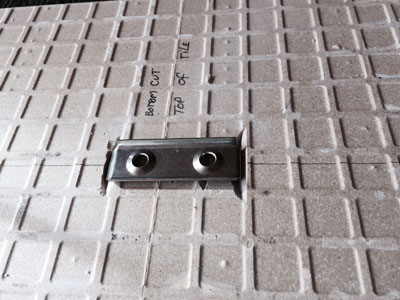Using the Tradesmans Slimline Supportclip Jig and cutter .

 PHOTO 2
PHOTO 2 Here we are showing the tile with the jig positioned to install the top cut into the tile .You can see the gauge at the bottom of the photo with the measurement markings on it .When putting the top cut into the panel the operator holds the Jig with backwards pressure , so it is positioned right
 PHOTO 3
PHOTO 3 Here in this photo we are positioning the Jig to put in the bottom cut . The position of the bottom cut is always set in the same position and as i said the joint is effected by the positioning of the top cut .To install the bottom cut you have to turn the Jig around and drop the Index Plungers down to hold against the tile while you push forward when doing the cut .That is why there is a restraint at the end of the work bench
 PHOTO 4
PHOTO 4 Here in this photo you can see the cuts in the top of the tile ( LHS ) and the bottom of the tile ( RHS). As you can see we also put another 2 cuts into the tile bed (LHS). This is done so as to be able to inject further epoxy into the matrix of the tile and thus give a far better bond between the tile and the Slimline Supportclip when it is positioned and epoxied into place .

PHOTO 5
Here we have the 2 tiles installed together ( no epoxy yet) with a zero ; joint. By drawing the line top to bottom on the tile , you are able to be able to see if the clips are installed in the right place and alignmen when you install the epoxy .

PHOTO 6
This shows the 100 mm grinder with the 65 mm blade installed.
 PHOTO 7
PHOTO 7
This shows two tiles one(RHS)with a full Slimline Supportclip and the other one has a clip that has the top of the clip straightened out so it can be used in any position, such as offset positioning of tiles in facades This straightening out is sometime done when installing rough face stone SUCH AS STACK STONE and ROCK FACED (see video )

PHOTO 8
Shows 2 tiles epoxied and joined together to give a zero joint. It also shows one Slimline clip with the top of the clip straightened out and epoxied into the tile . We always use the24 hr epoxy ( Gel 69 ), as it is stronger than the 5 minute one .
